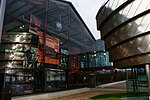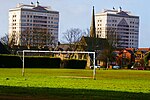Coatbridge Municipal Buildings
Category B listed buildings in North LanarkshireCity chambers and town halls in ScotlandCoatbridgeGovernment buildings completed in 1894Use British English from April 2022

Coatbridge Municipal Buildings, formerly Coatbridge Town Hall, is a municipal building in Dunbeth Road, Coatbridge, North Lanarkshire, Scotland. The building, which was the headquarters of Coatbridge Burgh Council, is a Category B listed building.
Excerpt from the Wikipedia article Coatbridge Municipal Buildings (License: CC BY-SA 3.0, Authors, Images).Coatbridge Municipal Buildings
Muiryhall Street,
Geographical coordinates (GPS) Address Nearby Places Show on map
Geographical coordinates (GPS)
| Latitude | Longitude |
|---|---|
| N 55.8637 ° | E -4.0217 ° |
Address
Muiryhall Street
Muiryhall Street
ML5 3NH
Scotland, United Kingdom
Open on Google Maps








